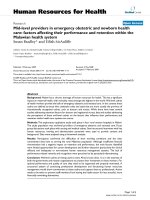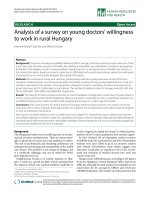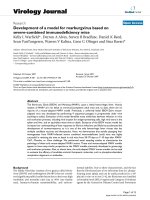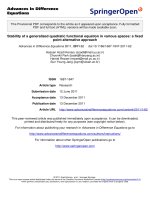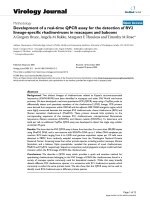Báo cáo sinh học: "Functions of O-fucosyltransferase in Notch trafficking and signaling: towards the end of a controversy" pptx
Bạn đang xem bản rút gọn của tài liệu. Xem và tải ngay bản đầy đủ của tài liệu tại đây (146.45 KB, 5 trang )
Minireview
FFuunnccttiioonnss ooff
OO
ffuuccoossyyllttrraannssffeerraassee iinn NNoottcchh ttrraaffffiicckkiinngg aanndd ssiiggnnaalliinngg::
ttoowwaarrddss tthhee eenndd ooff aa ccoonnttrroovveerrssyy??
Nicolas Vodovar* and François Schweisguth*
Address: Ecole Normale Supérieure, CNRS UMR8542, 46 rue d’Ulm, 75005 Paris, France. *Present address: Institut Pasteur, CNRS
URA2578, 25 rue du Dr Roux, 75015 Paris, France.
Correspondence: François Schweisguth. Email:
Notch proteins are evolutionarily conserved cell-surface
receptors for transmembrane ligands of the DSL family
(named after the Delta and Serrate ligands of Drosophila)
[1,2]. Signaling by Notch regulates a broad range of cell-fate
decisions during development and various human diseases,
including cancers, have been associated with defects in
Notch signaling.
The extracellular part of Notch contains 36 epidermal
growth factor-like (EGF) repeats carrying the ligand-binding
region and three Lin12/Notch repeats (LNRs) that limit
proteolytic cleavage of the receptor at the S2 site, and hence
limit its activation [2]. The EGF repeats are modified by two
types of O-linked glycosylation, O-glucosylation and O-fuco-
sylation (Figure 1a); both are important for Notch activity
[3-6] (Figure 1a).
O-fucosylation of Notch is catalyzed by an O-fucosyl-
transferase (Pofut1 in mammals and Ofut1 in Drosophila)
[7,8] that uses GDP-fucose as a substrate. The O-fucose
residue added by this O-fucosyltransferase can be further
elongated by the addition of an N-acetylglucosamine by
Fringe, an EGF-O-fucose β1,3 N-acetylglucosamyltransferase.
In Drosophila, the activity of Fringe is required for Notch
signaling events involved in boundary formation, in which
it reduces the affinity of Notch for Serrate while enhancing
that for Delta [9,10]. Given that Ofut1 is thought to be the
sole enzyme that O-fucosylates Notch, the activity of Fringe
is predicted to require the O-fucosylation activity of Ofut1.
However, Ofut1 has additional functions, and other catalytic
and non-catalytic activities have been proposed [8,11-16].
These include roles in the folding of Notch in the endo-
plasmic reticulum (ER), in Notch-ligand binding and in
endocytic trafficking of Notch. These different activities have
been incorporated into two distinct models (Figure 1b).
There are several observations that support each of these
models, and there has been controversy about which one is
correct. A recent paper in BMC Biology by Kenneth Irvine
and colleagues (Okajima et al. [17]) provides compelling
evidence in favor of one of these models.
TThhee mmooddeellss aanndd tthhee ssuuppppoorrttiinngg eevviiddeennccee
The first model [16] proposes that Ofut1 acts in the ER,
where it performs two separable functions: to O-fucosylate
Notch, thereby modulating Notch-ligand interaction, and to
AAbbssttrraacctt
The precise role of the
O
-fucosyltransferase Ofut1 in Notch-receptor trafficking has
remained controversial. A recent study sheds new light on the non-catalytic activity of Ofut1
and provides further evidence that Ofut1 acts as a chaperone in the endoplasmic reticulum.
BioMed Central
Journal of Biology
2008,
77::
7
Published: 28 February 2008
Journal of Biology
2008,
77::
7 (doi:10.1186/jbiol68)
The electronic version of this article is the complete one and can be
found online at />© 2008 BioMed Central Ltd
promote the correct folding of the extracellular domain of
Notch (a non-catalytic function). The evidence in support of
this model is as follows. First, Ofut1 is a soluble ER protein
[16,18]. It partially co-localizes with ER markers and acts, at
least in part, in the ER: the carboxy-terminal extremity of
Ofut1 contains a Lys-Asp-Glu-Leu (KDEL)-like motif that is
dispensable for its catalytic activity but is required for both
ER retention and function [16,18]. Second, Ofut1 is required
for secretion of Notch [16]. In ofut1 mutant cells, the Notch
protein accumulates in intracellular compartments marked
by ER markers, and knockdown of Ofut1 using double-
stranded RNA in cultured cells inhibits the secretion of a
soluble version of the Notch extracellular domain (NECD)
[15,16]. This activity of Ofut1 does not require its O-
fucosylation activity because expression of a mutant version
of Ofut1 demonstrated to be catalytically dead (Ofut1
R275A
)
7.2
Journal of Biology
2008, Volume 7, Article 7 Vodovar and Schweisguth />Journal of Biology
2008,
77::
7
FFiigguurree 11
O
-fucosylation of Notch and functions of Ofut1.
((aa))
Schematic representation of the
Drosophila
Notch receptor
The extracellular domain
(NECD) is composed of three Lin12/Notch repeats (LNRs) (black) and 36 EGF-like repeats; the EGF repeats are predicted to be either
O
-
glucosylated (cyan),
O
-fucosylated (yellow) or doubly modified (green) adapted from [19]. The S2 cleavage site is indicated by an arrow. The
intracellular domain (NICD) contains various elements involved in transcriptional activation: a RAM domain, seven ankyrin repeats (ANK), a
transactivation domain (TAD) and a PEST domain (P). TM, transmembrane domain.
((bb,,cc))
Two models for the roles of Ofut1 in Notch trafficking.
Each model is illustrated in a schematic cell that is shown as wild type on the left and
ofut1
mutant on the right, gray-shaded side. (b) Model 1: in
the ER, newly synthesized, unfolded Notch (with the NECD in red and the NICD in white) becomes properly folded (NECD in green) and is
O
-
fucosylated by Ofut1 (yellow diamond). It is then transported to the plasma membrane and adherens junctions (AJs, cyan) through the Golgi. In the
absence of Ofut1, Notch remains unfolded and is retained in the ER. (c) Model 2:
O
-fucosylated Notch is first transported via the Golgi to the
apical membrane and then transported to AJs by a transcytosis mechanism. In
ofut1
mutant cells, Notch goes to the membrane, is internalized and
accumulates in an uncharacterized endocytic compartment.
TA DRAM P
TM
LNR
EGF-like repeats
ANK
NECD NICD
(a)
Wild type
ofut1 Wild type ofut1
Golgi
Nucleus
(b)
ER
AJs
(c)
Golgi
ER
Ofut1 Ofut1
Model 1 Model 2
Ofut1
Nucleus
mostly rescues the Notch localization defects. In addition,
Ofut1 and Ofut1
R275A
both bind the NECD, and expression
of Ofut1
R275A
in cultured cells can increase both the amount
and the ligand-binding activity of secreted NECD [16].
Consistent with this proposed O-fucosylation-independent
activity, Notch localizes at the cell cortex in GDP-mannose
4,6-dehydratase (Gmd) mutants [16], which contain no
GDP-fucose [13], indicating that non-O-fucosylated Notch
exits the ER.
Together, these results led to a simple model (model 1,
Figure 1b) in which Ofut1 acts as an ER chaperone to pro-
mote the proper folding of the EGF repeats of Notch,
thereby ensuring its correct cell-surface localization and
ligand-binding activity.
The second model [12,13] proposes that Ofut1 acts at two
post-exocytosis steps in the trafficking of Notch: it regulates
both the endocytosis of Notch [13] and its transcytosis from
the apical plasma membrane to the adherens junctions
(AJs) [12]. This model is supported by the following obser-
vations. First, Ofut1 is required for the proper distribution
of Notch at AJs. In ofut1 mutant cells, Notch does not
accumulate at AJs but instead accumulates into intracellular
‘dots’ that co-localize with ER markers only poorly [13]. In
addition, surface-staining experiments indicate that a low
level of Notch is also present at the surface of ofut1 mutant
cells [12]. These data were interpreted [12,13] to suggest
that Ofut1 is not required for the ER exit and cell-surface
delivery of Notch.
Second, Ofut1 is required to regulate the endocytic traffick-
ing of Notch, as monitored by antibody uptake. Anti-Notch
antibodies are internalized in ofut1 mutant cells, albeit at a
lower level than in wild-type cells, but fail to accumulate in
endosomes [13]. It is therefore proposed that Notch
accumulates in an uncharacterized endocytic compartment
in ofut1 mutant cells. Finally, the second model is
supported by the observation that a lower level of
intracellular Notch is detected in Gmd mutant cells than in
ofut1 single-mutant or ofut1, Gmd double-mutant cells
[12,13]. This suggests that the endocytic activity of Ofut1
does not depend on its catalytic activity. In addition, the
failure of Notch to localize at AJs in Gmd mutant cells is
interpreted in the light of a speculative model of the
transcytosis of Notch to suggest that Ofut1 acts in a
catalysis-dependent manner to regulate the transcytosis of
Notch [12]. We feel that this transcytosis model needs
further experimental validation, so we will not detail the
possible role of Ofut1 in this process further. We note,
however, that this proposed role of Ofut1 in the trans-
cytosis of Notch suggests that the O-fucosylation activity of
Ofut1 is required for Fringe-independent signaling events.
Together, these observations suggest a model (model 2,
Figure 1c) in which Ofut1 regulates the endocytic trafficking
of Notch at a post-internalization step so that Notch
accumulates in an undefined endocytic compartment in the
absence of ofut1 activity.
Thus, these two models offer two different interpretations of
the cellular basis of the ofut1 mutant phenotype: in model
1, the reason Notch does not signal is because it is trapped
in the ER, whereas in model 2, it is because Notch accumu-
lates in an undefined endocytic compartment with a low
level of (inactive) Notch at the surface.
One implication of model 2 is that a fraction of Ofut1 must
escape ER retention and act in the endocytic pathway.
Consistent with this possibility, experiments using cultured
cells indicate that a fraction of Ofut1 is secreted, interacts
with the extracellular part of Notch at the cell surface, and is
internalized in a Notch-dependent manner [13]. In addition,
the Notch localization defects seen in cells treated with ofut1
double-stranded RNA can be rescued by adding Ofut1-
containing conditioned medium [13]. Whether this happens
in vivo is not clear. Indeed, ofut1 acts in a cell-autonomous
manner to regulate the localization of Notch, arguing that
secretion is not important in this regulation [12]. Moreover,
the observed rescue of the ofut1 knockdown phenotype by
extracellular Ofut1 could also be consistent with model 1,
given that endocytosed Ofut1 may be transported back into
the ER.
TToowwaarrddss tthhee eenndd ooff aa ccoonnttrroovveerrssyy
So, how can we distinguish between the two models?
Clearly, answering the following questions would help. Is
Ofut1 required in the ER or in an endocytic compartment?
Does Notch reach the cell surface in the absence of Ofut1
activity? Where does Notch accumulate in ofut1 mutant
cells? Is the O-fucosylation activity of Ofut1 required for
proper Notch localization and activity? Or is it only
required for Fringe-dependent signaling? Okajima et al. [17]
have addressed these issues and provide compelling
evidence in favor of model 1.
Okajima et al. [17] have shown that the O-fucosylation
activity of ofut1 is required for Fringe-dependent but not for
Fringe-independent signaling events. They found that
embryos lacking both maternal and zygotic contributions of
Gmd develop into larvae, as fringe mutant embryos do. The
complete loss of ofut1 activity results in a strong phenotype
mimicking a loss of Notch activity that is rescued to larval
viability by the expression of Ofut1
R275A
. These data show
that the O-fucosylation activity of Ofut1 is dispensable for
Notch signaling in the embryo. This conclusion is entirely
/>Journal of Biology
2008, Volume 7, Article 7 Vodovar and Schweisguth 7.3
Journal of Biology
2008,
77::
7
consistent with the observation that the activity of Fringe is
dispensable in the embryo. It is therefore clear that non-
fucosylated Notch can reach the cell surface and can signal.
Analysis by Okajima et al. [17] of the role of the O-
fucosylation activity of ofut1 during wing imaginal disc
development led to identical conclusions. Although the loss
of ofut1 activity in clones leads to phenotypes mimicking a
loss of Notch activity, expression of Ofut1
R275A
rescued
Notch receptor activity in these ofut1 mutant cells and led to
phenotypes mimicking a loss of fringe activity. This
confirms that non-fucosylated Notch can signal, and further
indicates that the fucosylation activity of ofut1 is required
only for Fringe-dependent signaling events. This therefore
implies that the transcytosis step of model 2, which was
proposed to be dependent on Ofut1 catalytic activity, is not
essential for Notch signaling.
Because the controversy over the exact role of Ofut1 is in
part due to methodological differences between the various
studies and also to technical limitations in subcellular
localization analysis, Okajima et al. [17] also re-examined
the localization of Notch in ofut1 mutant cells using a
detergent-free cell-surface staining protocol. A striking
difference in surface staining was observed between wild-
type and ofut1 mutant cells. This convincingly shows that
Notch is not present at detectable levels at the surface of
mutant cells. This contradicts the results obtained by Sasaki
et al. [12], who used a different protocol to assay the presence
of Notch at the cell surface of ofut1 mutant cells. Whether
the difference in protocols accounts for these opposite
conclusions remains to be addressed experimentally. The
second piece of evidence in support of a cell surface
accumulation of Notch in ofut1 mutant cells comes from
antibody uptake experiments showing that anti-Notch
antibodies can be internalized by ofut1 mutant cells [11].
However, as discussed by Okijama et al. [15], the low level
of antibody uptake can probably be accounted for by the
fluid-phase uptake of anti-Notch antibodies by live ofut1
mutant cells, followed by the specific retention of interna-
lized antibodies by Notch accumulating intracellularly.
Together, the published data are best interpreted as conclu-
ding that Notch does not reach the cell surface in ofut1
mutant cells.
Okajima et al. [17] next analyzed the distribution of Notch
in ofut1 mutant cells. Notch was shown to partially co-
localize with four different ER markers that, in fact, show
only partial co-localization among themselves. Thus, the
only partially overlapping distribution of ER markers may
explain the poor co-localization of Notch with the two ER
markers seen by Sasamura et al. [13]. Okajima et al. [17]
therefore propose that Notch accumulates in ofut1 mutant
cells in the ER, which is a heterogeneous organelle. Accordingly,
Notch should co-localize better with the sum of the signals of
the different ER markers. This remains to be tested.
In the light of these new data, it is clear that the O-fuco-
sylation of Notch is primarily required for Fringe-dependent
signaling events and that Ofut1 acts non-catalytically to
regulate the exit of Notch from the ER. Thus, Ofut1
probably acts as a chaperone in the ER to promote the
proper folding of the extracellular domain of Notch, as
described in model 1. Although the catalytic and non-cata-
lytic activities of Ofut1 can be experimentally uncoupled, it
is attractive to speculate that the O-fucosylation activity of
Ofut1 participates in the quality-control mechanism that
ensures that only properly folded Notch exits the ER.
Further analysis of the trafficking of non-fucosylated Notch,
produced for instance by Gmd mutant cells, would help
address this issue.
AAcckknnoowwlleeddggeemmeennttss
We thank A. Bardin and C. Perdigoto for critical reading of the manu-
script. N.V. is supported by the Agence Nationale pour la Recherche.
RReeffeerreenncceess
1. Schweisguth F:
NNoottcchh ssiiggnnaalliinngg aaccttiivviittyy
Curr Biol
2004,
1144::
R129-
R138.
2. Bray SJ:
NNoottcchh ssiiggnnaalllliinngg:: aa ssiimmppllee ppaatthhwwaayy bbeeccoommeess ccoommpplleexx
Nat
Rev Mol Cell Biol
2006,
77::
678-689.
3. Rampal R, Luther KB, Haltiwanger RS:
NNoottcchh ssiiggnnaalliinngg iinn nnoorrmmaall
aanndd ddiisseeaassee ssttaatteess:: ppoossssiibbllee tthheerraappiieess rreellaatteedd ttoo ggllyyccoossyyllaattiioonn
Curr
Mol Med
2007,
77::
427-445.
4. Stanley P:
RReegguullaattiioonn ooff NNoottcchh ssiiggnnaalliinngg bbyy ggllyyccoossyyllaattiioonn
Curr
Opin Struct Biol
2007,
1177::
530-535.
5. Acar M, Jafar-Nejad H, Takeuchi H, Rajan A, Ibrani D, Rana NA,
Pan H, Haltiwanger RS, Bellen HJ:
RRuummii iiss aa CCAAPP1100 ddoommaaiinn ggllyyccoo
ssyyllttrraannssffeerraassee tthhaatt mmooddiiffiieess NNoottcchh aanndd iiss rreeqquuiirreedd ffoorr NNoottcchh s
siigg
nnaalliinngg
Cell
2008,
113322::
247-258.
6. Ge C, Stanley P:
TThhee OO ffuuccoossee ggllyyccaann iinn tthhee lliiggaanndd bbiinnddiinngg ddoommaaiinn
ooff NNoottcchh11 rreegguullaatteess eemmbbrryyooggeenneessiiss aanndd TT cceel
lll ddeevveellooppmmeenntt
Proc
Natl Acad Sci USA
2008,
110055::
1539-1544.
7. Wang Y, Shao L, Shi S, Harris RJ, Spellman MW, Stanley P, Halti-
wanger RS:
MMooddiiffiiccaattiioonn ooff eeppiiddeerrmmaall ggrroowwtthh ffaaccttoorr lliikkee rreeppeeaattss
wwiitthh
OO
ffuuccoossee MMoolleeccuullaarr cclloonniinngg aanndd eexxpprreessssiioonn ooff aa nnoovveell GGDDPP
ffuuccoossee pprrootteeiinn
OO
ffuuccoossyyllttrraannssffeerraassee
J Biol Chem
2001,
227766::
40338-
40345.
8. Okajima T, Irvine KD:
RReegguullaattiioonn ooff nnoottcchh ssiiggnnaalliinngg bbyy OO lliinnkkeedd
ffuuccoossee
Cell
2002,
111111::
893-904.
9. Bruckner K, Perez L, Clausen H, Cohen S:
GGllyyccoossyyllttrraannssffeerraassee
aaccttiivviittyy ooff FFrriinnggee mmoodduullaatteess NNoottcchh DDeellttaa iinntteerraaccttiioonnss
Nature
2000,
440066::
411-415.
10. Moloney DJ, Panin VM, Johnston SH, Chen J, Shao L, Wilson R,
Wang Y, Stanley P, Irvine KD, Haltiwanger RS, Vogt TF:
FFrriinnggee iiss aa
ggllyyccoossyyllttrraannssffeerraassee tthhaatt mmooddiiffiieess NNoottcchh
Nature
2000,
440066::
369-
375.
11. Shi S, Stanley P:
PPrrootteeiinn
OO
ffuuccoossyyllttrraannssffeerraassee 11 iiss aann eesssseennttiiaall ccoomm
ppoonneenntt ooff NNoottcchh ssiiggnnaalliinngg ppaatthhwwaayyss
Proc Natl Acad Sci USA
2003,
110000::
5234-5239.
12. Sasaki N, Sasamura T, Ishikawa HO, Kanai M, Ueda R, Saigo K,
Matsuno K:
PPoollaarriizzeedd eexxooccyyttoossiiss aanndd ttrraannssccyyttoossiiss ooff NNoottcchh dduurriinngg
iittss aappiiccaall llooccaalliizzaattiioonn iinn
DDrroossoopphhiillaa
eeppiitthheelliiaall cceellllss
Genes Cells
2007,
1122::
89-103.
7.4
Journal of Biology
2008, Volume 7, Article 7 Vodovar and Schweisguth />Journal of Biology
2008,
77::
7
13. Sasamura T, Ishikawa HO, Sasaki N, Higashi S, Kanai M, Nakao S,
Ayukawa T, Aigaki T, Noda K, Miyoshi E, Taniguchi N, Matsuno K:
TThhee
OO
ffuuccoossyyllttrraannssffeerraassee OO ffuutt11 iiss aann eexxttrraacceelllluullaarr ccoommppoonneenntt
tthhaatt iiss eesssseennttiiaall ffoorr tthhee ccoonnssttiittuuttiivvee eennddooccyyttiicc ttrraaffffiicckkiinngg ooff NNoottcchh
iinn
DDrroossoopphhiillaa
Development
2007,
113344::
1347-1356.
14. Sasamura T, Sasaki N, Miyashita F, Nakao S, Ishikawa HO, Ito M,
Kitagawa M, Harigaya K, Spana E, Bilder D, Perrimon N, Matsuno
K:
nneeuurroottiicc
,, aa nnoovveell mmaatteerrnnaall nneeuurrooggeenniicc ggeennee,, eennccooddeess aann
OO
ffuuccoossyyllttrraannssffeerraassee tthhaatt iiss eesssseennttiiaall ffoorr NNoottcchh DDeellttaa iinntteerraaccttiioonnss
Development
2003,
113300::
4785-4795.
15. Okajima T, Xu A, Irvine KD:
MMoodduullaattiioonn ooff nnoottcchh lliiggaanndd bbiinnddiinngg bbyy
pprrootteeiinn
OO
ffuuccoossyyllttrraannssffeerraassee 11 aanndd ffrriinnggee
J Biol Chem
2003,
227788::
42340-42345.
16. Okajima T, Xu A, Lei L, Irvine KD:
CChhaappeerroonnee aaccttiivviittyy ooff pprrootteeiinn
OO
ffuuccoossyyllttrraannssffeerraassee 11 pprroommootteess nnoottcchh rreecceeppttoorr ffoollddiinngg
Science
2005,
330077::
1599-1603.
17. Okajima T, Reddy B, Matsuda T, Irvine KD:
CCoonnttrriibbuuttiioonnss ooff cchhaapp
eerroonnee aanndd ggllyyccoossyyllttrraannssffeerraassee aaccttiivviittiieess ooff
OO
ffuuccoossyyllttrraannssffeerraassee 11
ttoo NNoottcchh ssiiggnnaalliinngg
BMC Biol
2008,
66::
1.
18. Luo Y, Haltiwanger RS:
OO ffuuccoossyyllaattiioonn ooff nnoottcchh ooccccuurrss iinn tthhee
eennddooppllaassmmiicc rreettiiccuulluumm
J Biol Chem
2005,
228800::
11289-11294.
19. Moloney DJ, Shair LH, Lu FM, Xia J, Locke R, Matta KL, Halti-
wanger RS:
MMaammmmaalliiaann NNoottcchh11 iiss mmooddiiffiieedd wwiitthh ttwwoo uunnuussuuaall
ffoorrmmss ooff OO lliinnkkeedd ggllyyccoossyyllaattiioonn ffoouunndd oonn eeppiid
deerrmmaall ggrroowwtthh ffaaccttoorr
lliikkee mmoodduulleess
J Biol Chem
2000,
227755::
9604-9611.
/>Journal of Biology
2008, Volume 7, Article 7 Vodovar and Schweisguth 7.5
Journal of Biology
2008,
77::
7


